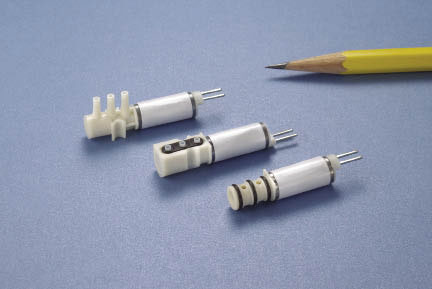Miniature pneumatics, sometimes called precision pneumatics, encompasses a range of pneumatic components that have been miniaturized for intended use in light- and medium-duty applications and for low-medium pressure ranges. In these systems, size and weight constraints apply or, more commonly, the need for precision is high. System pressures of 20 psi are not unheard of in miniature pneumatic applications.
Miniature pneumatics has found applications in medical/dental instruments, test equipment, analytics, pharmaceuticals, entertainment/animatronics, semiconductor, HVAC systems, aerospace, down-hole oil tools, machine tools, ink-jet printing, and process control systems. Miniature Pneumatic products encompass a range of scaled down parts including: Valves, cylinder, fittings, manifolds and tubing. Specialized components, such as nozzles and screens, are also seen on occasion.
For example, the evolution of medical equipment has expanded beyond the hospital environment and towards the home care and ambulatory environments. This has made portable, battery operated variants of traditional stationary equipment more attractive. In today’s culture, the persistent demand for reliable and innovative products compels companies to integrate new and more advanced technology into smaller packages.
A magnetically latched solenoid valve is suitable for reducing power consumption in applications where conventional, higher power valves have been used in the past. This type of design is suitable for compact, battery powered pneumatic instruments such as portable oxygen delivery systems, environmental gas samplers, and other OEM flow switching devices.
Similarly, properly designed miniature solenoid valves can improve patient comfort by reducing actuation noise. A typical solenoid valve has an inherent clicking sound when energized, which is caused by the metal-to-metal contact of the moving armature and stationary core. Quieter operational design found in some miniature pneumatics uses so-called whisper technology to greatly reduce sound levels. These valves are used for medical applications flowing gas or air, such as dialysis machines, patient monitors, ventilators/respirators and other bedside medical devices.
A selection of miniature fluid power components currently available include the following.
Plugs are the most successful method to seal drilled holes for critical applications. More than 100 million are in use where permanent leak-proof seals are required.
Restrictors feature small size, precision performance and long life. Single orifice and multi-orifice models cover a wide range of restriction and can be customized to meet special requirements.
Flow controls including restrictor check valves, directional flow controls and constant flow valves are available in a wide range of sizes to suit many applications.
Nozzles can produce either a hollow cone of atomized spray as in our Spin Jet or an accurately targeted jet of lubrication fluid.
Relief valves provide safety relief, linear, or high pressure operation. They cover a wide range of applications.
Shuttle valves styles include: spring biased with the emergency port normally closed; detented, where the poppet latches to close off either the emergency port or the normal port; selective shuttle valves with a non-biased loose ball design; and inverse shuttle valves, where the lower pressure inlet port is open to common instead of the higher pressure inlet port.
Safety screens protect hydraulic components from contamination. Manufacturers offer intermediate and high pressure etched screens; they can be customized to meet special requirements.
Piloting solenoid valves are designed for use in aerospace hydraulic and fuel systems, oil tool applications, and other challenging high pressure applications. These are critical in space and weight savings, as well as power consumption.
Pressure components include miniature restrictors for damping pressure transients, adjustable pulsation dampers, and miniature passive peak pressure recorders.


Hi Paul,
We are trying to design a micro 4 Port valve (4 selection to 1 Common) as common Valves on the market are too expensive.
Our thoughts are preferably to solenoid triggered by default.
Any ideas where we can start, solenoid suppliers for example.
Any detail at all would that may be helpful.
Best regards,
Keith Wilkinson